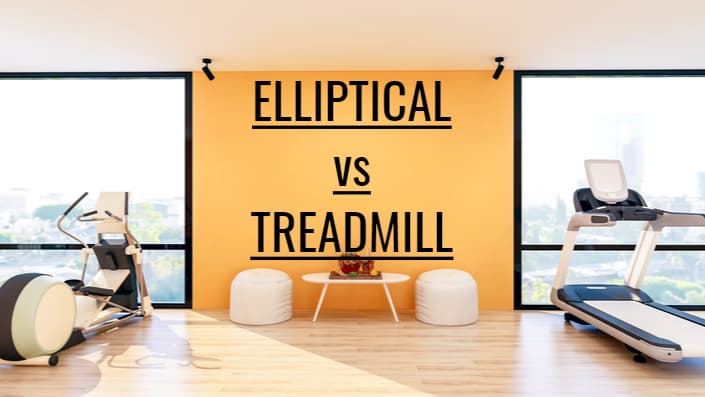Over the last two years, the home gym equipment market has exploded. Fitness equipment sales have grown by 170% during the COVID-19 pandemic. And the staple of most home gyms is a piece of cardio equipment.
We get many questions about which cardio machines are best. So today, we’re going to talk about treadmills and elliptical machines. Which cardio machine is better?
They’re both excellent cardio machines for your home gym, but one may be better for you than the other. Let’s find out.

Pros & Cons of Treadmills
Treadmills have been one of the most popular pieces of home cardio equipment sold over the past 50 years, and that trend has continued into 2021. What makes treadmills so popular? The answer is simple, the opportunity to burn calories and work on cardiovascular health any time of the day or year. No worries about going out for a walk or run once the sun has gone down or if foul weather has rolled in.
Of course, there are many other reasons treadmills are the go-to workout machines in many homes. Technology has vastly improved since the first treadmills of the 1960s, and they are now high-tech machines offering an interactive training experience.
There are still some negatives to owning a treadmill, but the positives far outweigh them. Let’s look at the pros and cons of buying a treadmill for your home and see if it’s the right choice for you.
- Joint health: Most modern treadmills have deck cushioning to protect your joints–which is far superior to running on concrete or asphalt.
- Ease of Use: You can set the difficulty level and forget it while watching TV or reading.
- Variety: You can simulate situations like marathoning, trail running, or use an interactive app like iFit.
- For Balance: Steady surface is suitable for those who have trouble negotiating curbs and other obstacles.
- Incline and Decline: Full control over speed, incline/decline.
- Programming: Different programs to keep things exciting and motivating.
- Indoor Training: Great way to train for a marathon or triathlon in inclement weather.
- Heart Rate: Can monitor heart rate easily on most models.
- Bone Health: Striking your feet on the deck stimulates bone growth. Excellent for people at risk for osteoporosis.
- Pricey: High-end models with high-tech features can cost many thousands of dollars–but there are entry-level and mid-level models that offer great features at a reasonable price.
- Bulky: Not all treadmill models work in small spaces or apartments. Check the footprint and weight carefully before purchase.
- Specialized Care: Repairs will often need a professional and aren’t cheap unless under warranty.
- Noisey: Some models are better than others when it comes to noise, but the key areas that generate that noise are the motor, inclining and declining the machine, and footfalls.
- Narrow Training Focus: Only works select muscles and cuts down on your agility.
Pros & Cons of Elliptical Machines
While treadmills have been on the market for nearly 60 years, elliptical machines have only been available half that time. An elliptical takes low-impact to the highest level with its ability to give you a solid cardio workout with no pounding to the joints. Most ellipticals give you settings that mimic walking, running or even stair climbing.
The ability for users to control the speed, intensity, and other variables while tracking all the statistics as you would on a treadmill, has made ellipticals very popular. All this while protecting the spine and all those joints from the pounding they would take on the street or on some treadmills. Whether in a commercial gym or at home, you can get a solid cardiovascular workout on just about any elliptical.
Let’s look at the pros and cons of buying an elliptical and see if maybe this is the best choice for you.
- Superior Calorie Burn: Burns more calories per minute than most treadmills.
- Low Impact: Provides a low-impact, joint-friendly workout with high intensity. Especially good for people with joint issues.
- Total Body Workout: Hits your upper as well as lower body.
- Variety: Programs and immersive visuals on some models.
- Reverse Stride: You can reverse stride.
- Injury Recovery: Great for recovering from injury.
- Variety: Modern ellipticals come with interactive fitness choices like iFit and onboard programs to keep you motivated.
- Can be Tricky to Use: It can be challenging to mount and dismount. Not suitable for those with balance issues.
- Low Impact: Does not build bone like a treadmill.
- Can Feel Unnatural: Some people don’t like the feeling of using an elliptical. It’s not real-world training.
- Statistics: The statistics on many ellipticals are inaccurate.
- Footprint: Some ellipticals are compact, and some take up a lot of space. Check before you buy.
Bottom Line: Ellipticals vs Treadmills
Variety, they say, is the spice of life, and when it comes to home cardio equipment, there are many machines to choose from. Choosing between a treadmill and an elliptical comes down to personal preference. Both devices offer an excellent way to train at home with lots of control and ways to track your stats.
There is no one “best cardio machine” for everyone. There are “best” machines for different people, however.
If you are a serious athlete doing marathons or triathlons, a treadmill is the way to go. Elliptical machines will work your heart and lungs but do not replicate real-world training. If you have balance issues, a treadmill is likely your best choice too.
An elliptical trainer is an excellent choice if you need a low-impact, high-intensity workout (especially if you have joint issues). Working your upper and lower body at the same time provides a superior calorie burn.
We like and recommend both pieces of equipment for your home gym. Just do your homework and don’t hesitate to ask us any questions.


Leave a Reply